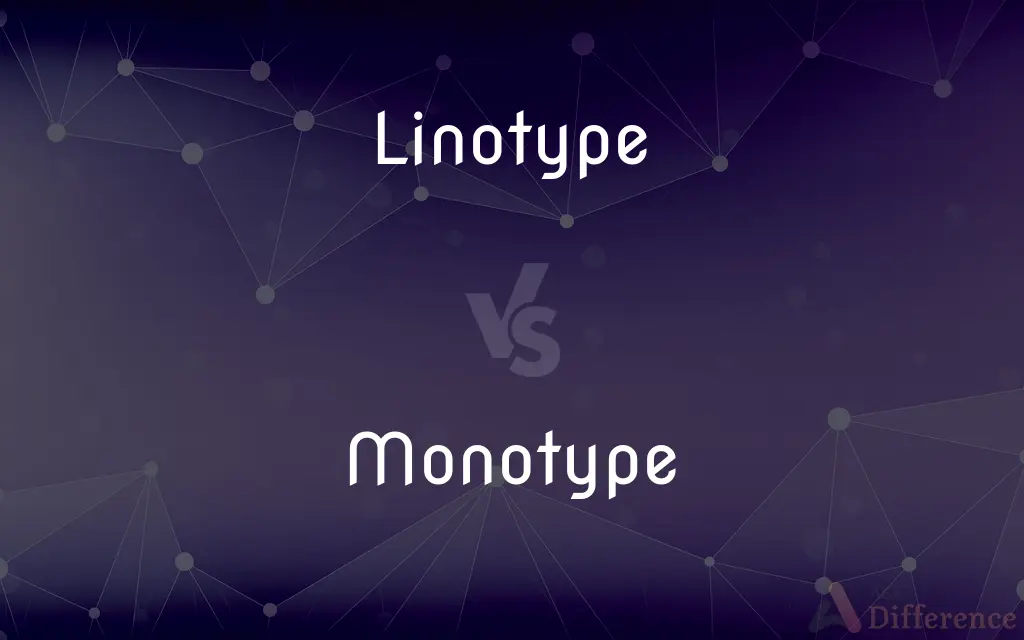Linotype vs. Monotype — What's the Difference?
By Tayyaba Rehman & Maham Liaqat — Updated on April 2, 2024
Linotype machines allowed for the automated setting of entire lines of type, revolutionizing newspaper publishing. Monotype, however, offered greater flexibility by casting individual letters, ideal for high-quality book printing.

Difference Between Linotype and Monotype
Table of Contents
ADVERTISEMENT
Key Differences
Linotype machines cast an entire line of type at once, creating a "line o' type" from molten metal, which was a breakthrough in speed for newspaper publishing. Monotype machines, on the other hand, cast individual letters and spacing, allowing for precise adjustments and higher quality in typesetting, particularly suited for books.
The linotype process streamlined the printing process by enabling faster typesetting, making it a staple in newspaper production where speed was crucial. Monotype, whereas, provided unmatched precision and flexibility, making it preferable for works requiring a high level of typographic quality, such as literature and specialized publications.
Linotype machines were operated by a keyboard, but the entire line had to be correct before casting; if an error was made, the whole line had to be retyped. Monotype typesetting, on the other hand, allowed for individual letter corrections, offering a significant advantage in reducing waste and increasing efficiency for detailed work.
One significant advantage of linotype was its economic efficiency for large runs, as it was faster and required less labor. However, Monotype, with its individual casting system, excelled in producing texts with extensive use of italics, scientific notation, or other complexities that required a higher degree of typographical detail.
Linotype's dominance in the newspaper industry lasted until the late 20th century when digital typesetting began to replace mechanical systems. Monotype, while also eventually overtaken by digital printing technologies, remains celebrated for its contribution to high-quality book publishing and its influence on typographic standards.
ADVERTISEMENT
Comparison Chart
Type Casting
Entire lines at once
Individual letters
Primary Use
Newspapers
High-quality book printing
Error Correction
Must recast the entire line
Can replace individual letters
Flexibility
Less, due to line casting
High, due to individual letter casting
Economic Efficiency
Higher for large runs
Lower, but excels in quality
Compare with Definitions
Linotype
Automated line casting.
Linotype machines revolutionized newspapers by enabling faster typesetting.
Monotype
Precision in individual casting.
Monotype casting allowed for meticulous typesetting, ideal for quality book printing.
Linotype
Replaced by digital technologies.
Digital typesetting technologies eventually replaced linotype machines.
Monotype
Corrections made easy.
Monotype systems enabled easy correction of typesetting errors by replacing letters.
Linotype
Operated by a keyboard.
Despite being keyboard-operated, linotype required complete accuracy before casting.
Monotype
High typographic flexibility.
The ability to adjust individual letters made monotype superior for detailed works.
Linotype
Speed over flexibility.
The linotype process prioritized speed, making it less flexible for detailed corrections.
Monotype
Influential in typographic standards.
Monotype's contributions to typesetting have had a lasting impact on typographic quality.
Linotype
Economic for newspapers.
Linotype's efficiency made it the preferred choice for newspaper production.
Monotype
Ideal for complex layouts.
Its precision made monotype preferable for texts with complex layouts or notations.
Linotype
A machine that sets type on a metal slug, operated by a keyboard.
Monotype
(Biology) The sole member of its group, such as a single species that constitutes a genus.
Linotype
A form of typesetting machine in which a complete line of characters is set at once.
Monotype
A unique print made by pressing paper against a painted or inked surface.
Linotype
The slug produced by such a machine, or matter composed in such lines.
Monotype
A print made by creating the design using oil paint or printer's ink on metal or glass, then transferring the image directly to paper.
Linotype
To prepare (printed matter) using a linotype machine.
Monotype
The technique of making such prints.
Linotype
A kind of typesetting machine which produces castings, each of which corresponds to a line of separate types. By pressing the keys of a keyboard like one on a typewriter, the matrices for one line are properly arranged; the entire line, or stereotype, or slug, is then cast and planed, and the matrices are returned to their proper places, the whole process being automatic.
Monotype
(biology) A monotypic taxon.
Linotype
A typesetting machine operated from a keyboard that casts an entire line as a single slug of metal
Monotype
A keyboard-operated typesetting and casting machine that makes and sets separate characters.
Monotype
(sailing) A sailboat designed to be crewed or raced by a single person.
Monotype
(comptheory) In the Hindley–Milner type system, a single specific data type.
Monotype
(transitive) To produce a monotype of.
To monotype an engraving
Monotype
Having but one type; containing but one representative; as, a monotypic genus, which contains but one species.
Monotype
The only representative of its group, as a single species constituting a genus.
Monotype
A print (but one impression can be taken) made by painting on metal and then transferring the painting to paper by pressure; also, the process of making such prints.
Monotype
A kind of keyboard-operated typesetting and casting machine that makes and sets separate characters.
Monotype
(biology) a taxonomic group with a single member (a single species or genus)
Monotype
A typesetting machine operated from a keyboard that sets separate characters
Common Curiosities
Why is Monotype preferred for high-quality printing?
Its ability to cast individual letters allows for precise adjustments, making it ideal for high-quality printing.
What is Linotype?
Linotype is a typesetting machine that casts entire lines of type at once, used primarily for newspapers.
Are Linotype and Monotype still in use today?
Both systems have largely been replaced by digital typesetting technologies.
What is Monotype?
Monotype is a typesetting system that casts individual letters, allowing for high precision, ideal for book printing.
Which system offers better economic efficiency?
Linotype offers better economic efficiency for large runs, whereas Monotype excels in quality.
What was the main advantage of Linotype over Monotype?
Linotype's main advantage was its speed and efficiency in producing large volumes of text, such as newspapers.
How do Linotype and Monotype differ in casting?
Linotype casts entire lines, while Monotype casts individual letters, offering greater flexibility.
Can Linotype machines correct individual letters?
No, errors require recasting the entire line in Linotype systems.
Which is more efficient for newspaper production?
Linotype is more efficient for newspapers due to its speed and lower labor requirements.
What makes Monotype more flexible?
Monotype's individual letter casting allows for easy corrections and detailed typographic arrangements.
What role did Linotype play in the newspaper industry?
Linotype revolutionized the newspaper industry by significantly speeding up the typesetting process.
How did digital technologies affect Linotype and Monotype?
Digital typesetting technologies eventually made both Linotype and Monotype systems obsolete.
Which typesetting system allowed for individual letter corrections?
The Monotype system allowed for corrections by replacing individual letters.
Why was Monotype favored for books and complex texts?
Its precision and flexibility made it suitable for high-quality books and texts with complex layouts.
How did Monotype improve typographic standards?
Monotype allowed for precise control over typesetting, influencing high standards in typographic quality.
Share Your Discovery

Previous Comparison
Artisan vs. Guild
Next Comparison
History vs. ArchaeologyAuthor Spotlight
Written by
Tayyaba RehmanTayyaba Rehman is a distinguished writer, currently serving as a primary contributor to askdifference.com. As a researcher in semantics and etymology, Tayyaba's passion for the complexity of languages and their distinctions has found a perfect home on the platform. Tayyaba delves into the intricacies of language, distinguishing between commonly confused words and phrases, thereby providing clarity for readers worldwide.
Co-written by
Maham Liaqat















































